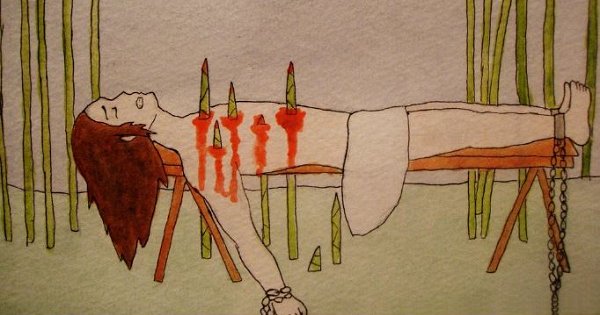
Brutal ancient torture methods 🧵👇
1. Scaphism: Victims were placed in two hollowed-out logs or boats, one inverted on top of the other. With their heads and limbs sticking out and their bodies trapped inside, the victim was force-fed milk and honey.
The torturers would smear the milk & honey over the victim’s body as well. Flies & other insects would be the first to arrive, but then the vermin arrived to not only feast upon the prisoners, but enter their bodies to fatally eat them from the inside out.

Tickle torture: The victim needed to be tied down & completely immobile. Their feet were dipped in saltwater & then a goat, attracted to the salt, would lick their feet. The cycle of dipping, licking, and tickling took a physical and psychological toll on the victim more and more the longer it went on. The uncontrollable laughter evolved into vomiting, loss of bladder control, and, in some cases, loss of consciousness.
It remains unclear if this method was ever used in practice as it is only described in the 1502 Tractatus de indiciis et tortura by the Italian jurist and monk Franciscus Brunus de San Severino – a treatise that actually cautioned against torture in general – and while it seems clear that Franciscus Brunus had not made up this practice, the issue is left open whether the inclusion in the treatise is based on hearsay, (reliable) eye-witness accounts, or personal experience.

Bamboo Torture: Bamboo can grow super fast, at a speed of forty millimeters (one and a half inches) per hour.
The torturers strapped the victim to a scaffold that was above young bamboo shoots. Since the bamboo grows super fast, the shoots soon began protruding through the victim. The victim experienced immense pain and eventually died.
The growing bamboo torture is believed to have been used during World War II on Allied POWs by the Japanese.

The Wheel of Catherine was common during the Middle Ages. The victim was either broken by the wheel or broken on the wheel. In the first, an executioner dropped a wheel on the victim to break their bones. In the second, the victim was tied to a wheel so that an executioner could systematically break their bones with a hammer.
Afterward, the victim would often be left on the wheel for hours, or even days, their broken limbs gruesomely intertwined in the wheel’s spokes. Needless to say, it frequently took them a long time to die.
The Blood Eagle: This torture method was detailed in Norse poetry. It begins with the skin on your back being sliced open, exposing your rib cage. Your ribs are then snapped back, making it look like you have wings. The lungs are then be dragged out and left hanging until you die.
There is not a ton of evidence about this method. It is still believed to be true but experts believe the victim would die long before the torture was completed.

The Judas Cradle was a torture device where the victim would be placed on top of a wooden pyramid with the triangular end inserted in the victim’s anus or vagina. Arms and feet were tied or weighted in order to ensure maximum pain as gravity slowly pulled the victim downward.
More often than not, the Judas Cradle was used to extract confessions or specific information from victims, so the addition of weights could increase the horror. Depending on the rate of the pyramid-sitter’s progress, this torture could last anywhere from a few hours to a full day.
While the torture was not usually intended to be fatal, it often was. Since the device was never cleaned, survivors experienced a high incidence of infection, which was effectively a death sentence in the centuries before antibiotics.

The Spanish Donkey followed a similar principal as the Judas Cradle, letting gravity do most of the work. Victims were seated on a vertical wood board with an inverted V-shaped wedge on top. Weights were then attached to their feet, placing all the combined pressure on that one sharp point to create a sensation like being split down the middle.
While there are accounts of this method being used on blasphemers during the Spanish Inquisition, the so-called Spanish Donkey is a play on a familiar form, one that extended to the United States, from the “riding the rail” punishments of the early Colonial Era to “The Mule,” on which Confederate soldiers captured in the Civil War would ride until they lost consciousness.
• • •
